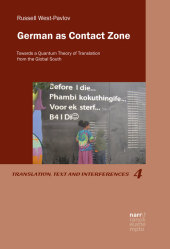 Neuerscheinungen 2019Stand: 2020-02-01 |
Schnellsuche
ISBN/Stichwort/Autor
|
Herderstraße 10
10625 Berlin
Tel.: 030 315 714 16
Fax 030 315 714 14
info@buchspektrum.de |

Russell West-Pavlov
German as a Contact Zone
Towards a Quantum Theory of Translation from the Global South
1. Auflage. 2019. 358 S. 220 mm
Verlag/Jahr: NARR 2019
ISBN: 3-8233-8143-1 (3823381431)
Neue ISBN: 978-3-8233-8143-3 (9783823381433)
Preis und Lieferzeit: Bitte klicken
This book suggests that linguistic translation is one minute province of an immense process of creative activity that constitutes the world as an ongoing dynamism of unceasing transformation. Building upon the speculative quantum gravity theory, which provides a narrative of the push-pull dynamics of transformative translation from the very smallest scales of reality to the very greatest, this book argues that the so-called translative turn of the 1990s was correct in positing translation as a paradigmatic concept of transformation. More radically, the book stages a provocative provincialization of linguistic translation, so that literary translation in particular is shown to display a remarkable awareness of its own participation in a larger creative contact zone. As a result, the German language, literary translations in and out of German, and the German-language classroom, can be understood respectively as quantum contact zones.
Russell West-Pavlov is Professor of Anglophone Literatures at the University of Tübingen and Research Associate at the University of Pretoria.
Contents
Acknowledgements
Introduction
Rostov-Luanda-[Berlin]
Berlin coming and goings
German as contact zone
Generalized translation
Plan of the book
PART 1: Translation in theory
Chapter 1: Turning Translation
From translation in culture to culture as translation
Defending and infringing the translational border
Translation and cultural catachresis
The relationality of translation
Chapter 2: Provincializing language I: The translator as Anthropologist
Language beyond language
Provincializing language or not
Objection 1.1: Self-referentiality, systemicity, sovereignty
Objection 1.2: Historical precursors: Enlightenment, the colonies, the Holocaust
Objection 2: The entanglement of icon, index and symbol
Chapter 3: Provincializing language II: The translator as shaman
Translation at the heart of things themselves
Interlude: Provincializing language means provincialization as process .
Provincialization and porosity, translation and verbing
Chapter 4: Translation as information Translation, information, life
The semiosphere as translation worlds
Chapter 5: Towards a quantum theory of translation
Quantum (gravity) theory
Quantum translation theory
Chapter 6: Quantizing German
Quantizing language
Quantizing German
Foreign languages in German
PART 2: Theory in translation
Chapter 7: Translating Sebald Translating Conrad
Reconnection
Translating Sebald Translating Conrad
Marlows grove of death
Text as contact zone
Chapter 8: Turning Translation Inside-Out: Vladislavi, Eich, Brückner
Translation and Transition
Translating Translation
Eich as translator
Chapter 9: Kinsella transposing Hamburger translating Hölderlin
Walking
History
War
Chapter 10: Jumping on Tram 83
The near-future
Translating (or failing to translate) for the future
What says the clock?
PART 3: Translating Translation in Teaching
Chapter 11: Translating Transformation: Teaching and Translating a Sonnet
by Derek Walcott
Walcotts The Morning Moon
The sonnet and creative constraint
Postcolonial resistance?
Landscape, teaching and translating
Chapter 12: The German Classroom as a Contact Zone
Ausländisch für DeutscheForeignish for Germans
Foreign languages in the German-language school
Translation in the classroom
Resonance as translation
Chapter 13: Blackboard as Fourth Wall: classrooms, race, translation and the contemporary crisis in Germany
Racism as a global phenomenon
Systemic connections
Connections: Performatives, Affect and Agency
The Classroom in the World
Conclusion: Before I die
Appendix: The Multicultural and multilingual classroom
The fate of the Federal Republic in the twenty-first century
Polylingual schools and a pluricultural society as the starting point for new approaches to EFL
EFL as a model for diversity learning
Ambivalent evidence from textbooks
The real existing classroom as opportunity: what now?
Bibliography


